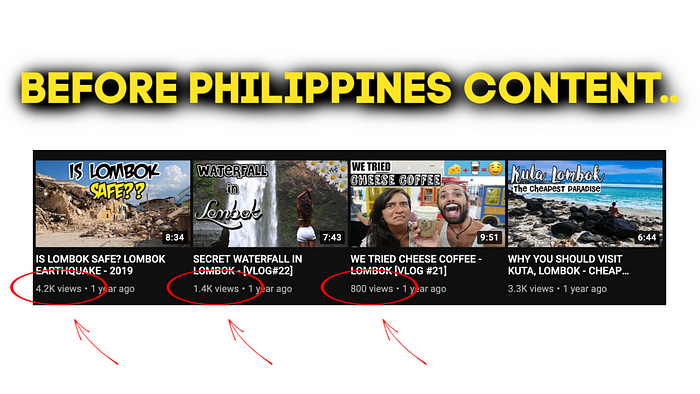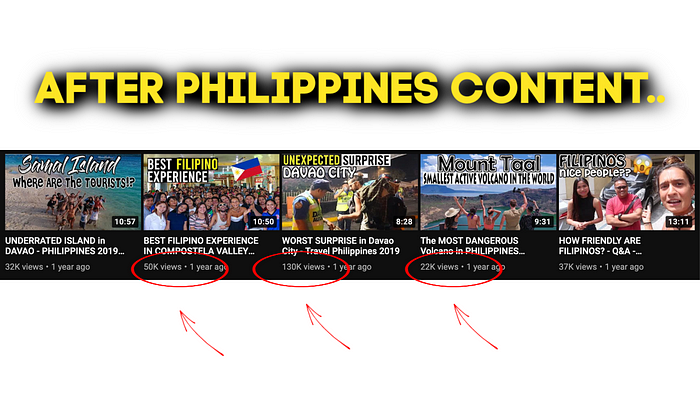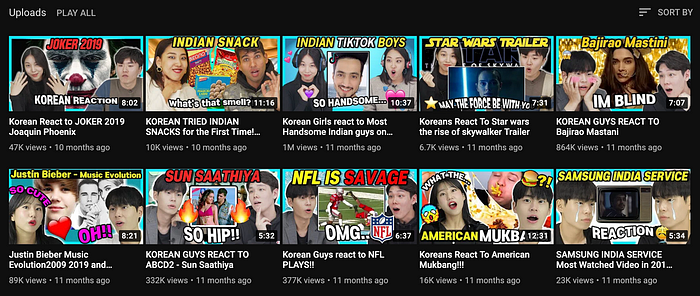1 Dirty Way YouTubers Get Famous That Will Make You Angry
Uploading…
…anddd…published.
*Refresh*
…Wow.
Sometimes as writers and vloggers we publish something that’s as hot as molten magma — and we know it.
We know that as soon as we publish said creation it’s going to cause a lot of controversy online. Some creators avoid this situation like the plague, but you see, four months ago I decided not to.
I’m about to tell you a story about how I steered directly into it back in June. I did it with the video you see below:
The PINOYBAITING Needs To STOP
This video made the rounds on social media, and tons of vloggers who were guilty of what I called “pinoybaiting” actually responded to it.

In total, my video has received close to half a million views on Facebook and YouTube.
By the end of my story, you’ll understand a darker side to social media marketing and how some vloggers exploit entire countries to get more views on YouTube.
Are you sure you want to go down this rabbit hole with me?
Some Vloggers Use Countries to Get More Views
Some foreign vloggers come to the Philippines and deliberately react/make content about this country just to get more views.
“That’s so strange!” you might say. You might think simply putting “Philippines” in the title of a video wouldn’t do much for view counts or traction.
Oh boy…
Here are the facts. The Philippines is the social media capital of the world.
Experts say that because Filipinos have an extraordinarily high usage time of four hours per day on social media. There are also some 60+ million Facebook users in the country.

Here’s a picture of the views a now-famous pair of vloggers used to get on their videos before they came to the Philippines. Pay attention. They only averaged about 2,000 views per video.

And here are the views after they went to the Philippines. They started seeing a 25x increase in views and went from 2,000 views per video to 50,000 views per video.
That’s the power of what we’d call pinoybaiting in action.
For the record, it’s not a Philippines-only phenomenon.

Here’s a screenshot from a channel called “World Reacts.” Here we can see these Korean YouTubers react to the NFL, India, and even American mukbang.
How do we know they’re Korean? Because they keep telling us they’re Korean in every video.
Does that make them thought experts or something?
No, it doesn’t — they’re actually employing a very intelligent marketing tactic that’s predicated on the pride of the viewer.
They’re reacting to American football. I must say that I’ve always wondered what other countries think of the USA’s most popular things. By telling us they’re Korean in every video, viewers on YouTube know they’re foreigners. Now we get to see what people from around the world think of our favorite shit.
It’s cool, right?
It actually is very cool. I love asking travelers in hostels what they think of America over a couple of beers. It’s nice to get genuine reactions from people.
The problem is, all of YouTube has figured out that if they frame themselves as “foreigners” and react to stuff from other countries, they can hit the social media lottery.
And in the Philippines, this “gaming” of Pinoy pride to get more views has reached unprecedented levels.
Here Are the World’s Best Pinoybaiters

Here are a few examples of foreigners praising Filipino shopping malls.
I’m really happy they’re so impressed with Filipino architecture! I mean, who knew people could be so obsessed with shopping malls in the first place.
The first thing I want to do when I walk into a shopping mall is make a vlog about it, am I right?
Right?
You will find overwhelming examples of ridiculous, egregious clickbait complete with a Philippine flag in the thumbnail all over YouTube.
It’s almost as if everybody knows what they’re doing.
It’s almost as if it has nothing to do with actually being surprised by Filipino culture and more to do with how they can mine as many views as quickly as possible.
When you look back on the catalog of vlogs for these great creators, you’ll see a watershed moment when they mention the Philippines for the first time.
Their views go from 1,000 per video to 50,000. It’s like the floodgates of the YouTube Gods open right in front of them.
The point is, it’s definitely a thing. I should know — I am one of the culprits.
I Had Enough and Called Everybody Out
My YouTube channel was built off the back of Philippines-based content. The difference between me and other vloggers is I cared about the country years before I started vlogging.
I won’t act like I was blameless, though.
About two years into my vlogging journey, I decided I had enough and called everybody out on the pinoybaiting — including myself.
It caused a shockwave through YouTube and social media. My videos on YouTube hardly ever get past 10,000 views, but this one flew past 100,000 in a matter of days. On Facebook, it flew past 250,000 views rather quickly, too.
I had an outpouring of comments saying stuff like, “FINALLY! Somebody said this!”
We Have a Responsibility as Vloggers and Bloggers
I have a problem with vloggers who quite frankly use a country they never plan to help in any tangible way to make money and get famous.
While many Filipinos still live in poverty, they bask in fame, money, and, many times, live outside the Philippines entirely.
That’s right, all these vloggers say they love the Philippines so much and then they move out after they get famous. It’s brilliant, isn’t it?
And they never once use their platform (or money) to help local charities here or improve the country they say they love so much.
Everything you do online is marketing.
If you’re a famous vlogger or blogger, some brands would pay an arm and a leg just to be mentioned in a tweet.
I want readers to understand that many content creators are not genuine. I’ve been around for four years and I’ve built a large following on four different platforms.
Sadly, genuine marketing — genuine content — is far too often the exception rather than the rule.
And I must say that I myself have contributed to the negative side of content creation online — especially in the Philippines.